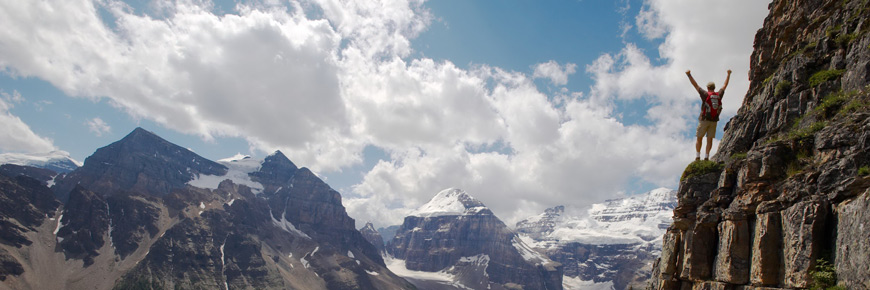
Devil's Lake in the Lake Louise area of Banff National Park, one of seven parks in the Canadian Rocky Mountain Parks World Heritage site.
© Banff Lake Louise Tourism
Canadian Rocky Mountain Parks
Alberta and British Columbia
Date of Inscription: 1984 (ext. 9 Dec 1990)
Some of the best-known mountain scenery on Earth is concentrated in a set of seven parks in the Canadian Rocky Mountains. Indeed, in much of the world, mention of Canada evokes images of snow-capped peaks and chateauesque hotels in parks named Banff or Jasper. More than nine million people annually visit the seven preserves along the Alberta-British Columbia border.
Justification of outstanding universal value
The Canadian Mountain Parks was designated as a World Heritage site by UNESCO’s World Heritage Committee under the following criteria:
Criterion (vii): The seven parks of the Canadian Rockies form a striking mountain landscape. With rugged mountain peaks, icefields and glaciers, alpine meadows, lakes, waterfalls, extensive karst cave systems and deeply incised canyons, the Canadian Rocky Mountain Parks possess exceptional natural beauty, attracting millions of visitors annually.
Criterion (viii): The Burgess Shale is one of the most significant fossil areas in the world. Exquisitely preserved fossils record a diverse, abundant marine community dominated by soft-bodied organisms. Originating soon after the rapid unfolding of animal life about 540 million years ago, the Burgess Shale fossils provide key evidence of the history and early evolution of most animal groups known today, and yield a more complete view of life in the sea than any other site for that time period. The seven parks of the Canadian Rockies are a classic representation of significant and on-going glacial processes along the continental divide on highly faulted, folded and uplifted sedimentary rocks.
Full description
There are four national parks in the ensemble - Banff, Jasper, Yoho and Kootenay. They account for most of the World Heritage property’s 23,600 square kilometres. Adjoining them are three British Columbia provincial parks - Mount Robson, Mount Assiniboine and Hamber. Banff, built around the Cave and Basin Hot Springs found by CPR workers building the transcontinental railway in the early 1880s, became Canada’s first park preserve in 1885, and the birthplace of Canada’s national park system.
In the following half-century, the park was expanded to encompass a wealth of natural wonders: jagged peaks and conifer-clad slopes, silt-laden glacial streams and turquoise lakes, the vast Columbia Icefield and the complex Castleguard Caves. The Burgess Shale, in Yoho, contains one of the world’s most significant finds of soft-bodied, Middle Cambrian-age marine fossils, with about 150 species, including some bearing no resemblance to known animals.
More Information
Parks Canada:
Jasper National Park of Canada
Kootenay National Park of Canada
Cave and Basin National Historic Site of Canada
Province of British Columbia:
Mount Assiniboine Provincial Park
World Heritage Centre:
World Heritage - Canadian Rocky Mountain Parks
The Burgess Shale Geoscience Foundation
Related links
- Anticosti, Quebec
- Tr’ondëk-Klondike, Yukon
- Writing-on-Stone / Áísínai’pi
- L’Anse aux Meadows National Historic Site
- Nahanni National Park Reserve
- Dinosaur Provincial Park
- Kluane / Wrangell-St.Elias / Glacier Bay /...
- Head-Smashed-In Buffalo Jump
- SG̱ang Gwaay
- Wood Buffalo National Park
- Historic District of Old Québec
- Gros Morne National Park
- Old Town Lunenburg
- Waterton-Glacier International Peace Park
- Miguasha National Park
- Rideau Canal
- Joggins Fossil Cliffs
- Landscape of Grand Pré
- Red Bay Basque Whaling Station
- Mistaken Point
- Pimachiowin Aki
- Date modified :